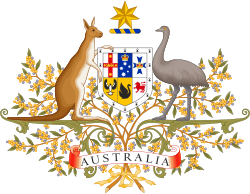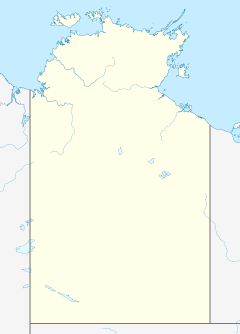Northern Territory v Mr Griffiths and Lorraine Jones facts for kids
The case of Northern Territory v Mr A. Griffiths (deceased) and Lorraine Jones on behalf of the Ngaliwurru and Nungali Peoples [2019] HCA 7 was an important native title court case in Australia. It was heard by the highest court in the country, the High Court of Australia. This case was about an appeal made by the Northern Territory government and the Australian Commonwealth government. They were appealing a decision made by a lower court, the Full Court of the Federal Court of Australia.
The High Court decided to lower the amount of money that was to be paid to the Ngaliwurru People and the Nungali People. This money was meant to make up for things the Northern Territory government had done that took away (or "extinguished") their native title rights. Native title means the special rights and interests that Aboriginal and Torres Strait Islander peoples have over land and waters, based on their traditional laws and customs.
The total payment was reduced from $2,899,446 to $2,530,350. This money was for both financial losses and non-financial losses, like cultural and spiritual harm, plus interest. The High Court's decision meant that the appeals by the Northern Territory and the Commonwealth were partly successful. This case is seen as one of the most important native title cases since the famous Mabo v Queensland (No 1) and Mabo v Queensland (No 2) decisions. The Ngaliwurru and Nungali Peoples live in Timber Creek, Northern Territory.
Contents
Understanding Native Title in Timber Creek
For many years, the Ngaliwurru and Nungali Peoples have been working to have their native title rights recognised. In 2006, the Federal Court of Australia decided that these groups held native title rights in the town of Timber Creek. At first, the judge said these rights were "non-exclusive," meaning others could also use the land. However, after an appeal in 2007, a higher court said these rights were "exclusive," meaning only the Ngaliwurru and Nungali Peoples had rights to the land.
Later, in 2014, another Federal Court judge ruled that the Northern Territory government had to pay compensation to the Ngaliwurru and Nungali Peoples. This was because the government had done things that took away (extinguished) these native title rights. These actions, called "compensable acts," included building public roads and giving out leases for development. These actions happened in the late 1900s, after the Racial Discrimination Act 1975 became law. This Act was created by the Parliament of Australia to make sure everyone is treated fairly, no matter their race.
First Compensation Decision (2016)
This was the first time a court decided how much money the Ngaliwurru and Nungali Peoples should get. The case was heard in the Federal Court of Australia. The judge, John Mansfield, made his decision on August 24, 2016.
It had already been decided that the Northern Territory government had to pay for taking away native title rights. So, in 2011, Alan Griffiths and Lorraine Jones, representing the Ngaliwurru and Nungali Peoples, asked the Federal Court for compensation. This was under the Native Title Act 1993. Their claim was about 53 actions that affected 39 land lots and four public roads. However, compensation was only given for 31 of these actions.
How the Federal Court Calculated the Money
Judge Mansfield first decided that the Ngaliwurru and Nungali Peoples should receive $3,300,661. This amount was for the loss of their land rights.
- $512,400 was for the direct financial loss.
- $1,488,261 was for interest on that financial loss.
- The remaining $1,300,000 was for the "intangible cultural and spiritual loss." This means the harm caused to their connection to the land, their traditions, and their spiritual beliefs.
The judge calculated the financial part of the compensation as "80% of the market value" of the land. He felt that the usual way of valuing land wasn't right because the only buyer for this land could be the government. Any Ngaliwurru and Nungali people from the Maiyalaniwung, Yanturi, Makalamayi, Wantawul, or Wunjaiyi tribes of Timber Creek could share in this compensation.
Appeal to the Full Federal Court (2017)
The Northern Territory and the Commonwealth of Australia were not happy with Judge Mansfield's decision. They appealed it to the Full Court of the Federal Court. This appeal case was called Northern Territory of Australia v Griffiths [2017] FCAFC 106.
The Northern Territory government argued that it was wrong to value the native title rights at 80% of the land's market value. They said that the legal system shouldn't value non-exclusive native title the same way it would value land owned by someone who isn't Indigenous. They believed this calculation was incorrect because it considered the race of the people, not just the type of land ownership.
The Northern Territory government thought the compensation should be based on how much the land was used and its "negotiation value." They also argued that the judge was wrong to ignore an expert's opinion that the compensation should be no more than 50% of the land's value. The Commonwealth of Australia also agreed that the financial value should be 50% of the land's value. However, the Ngaliwurru and Nungali Peoples argued that the value of their lost rights should be 100% of the land's full market value.
Full Federal Court's Decision
The Full Court of the Federal Court agreed that the first judge had made some mistakes. They found that the native title rights had been valued too highly. So, they changed the compensation amount. They decided that the compensation for financial loss should be 65% of the land's market value.
This decision reduced the total compensation from $3,300,661 to $2,899,446. The amount for financial loss went down from $512,400 to $416,325. The interest was then recalculated based on this new amount. The $1,300,000 for cultural and spiritual loss stayed the same. This case was heard by three judges: Anthony North QC, Michael Barker QC, and Debra Mortimer.
High Court of Australia's Final Ruling
The case of Northern Territory v Alan Griffiths and Lorraine Jones is considered a "landmark" native title case. This is because it was the first time the High Court had to decide how to calculate compensation for native title that had been taken away. The rules for this are in the Native Title Act 1993.
This decision by the High Court will set an example for all future native title compensation cases. It means that significant amounts of money might be paid in other cases where native title rights have been lost or harmed.
The High Court decided that the compensation for financial loss should be 50% of the land's value. This was a reduction of 15% from the 65% decided by the Full Federal Court. The High Court ordered the Northern Territory government, not the Commonwealth government, to pay this compensation. This is because the Northern Territory government was responsible for all the actions that took away the native title rights in Timber Creek.
The High Court also changed an earlier ruling. It decided that the native title rights of the Ngaliwurru and Nungali Peoples in Timber Creek were "non-exclusive." This means they did not have the power to stop people from entering the land or to decide who could access it. This "non-exclusive" decision was the main reason why the High Court changed the financial compensation from 65% to 50% of the land's value.
There were three main legal issues brought to the High Court in this case. The High Court partly agreed with the appeals made by the Northern Territory and the Commonwealth. This led to the reduction in compensation for the Ngaliwurru and Nungali Peoples. The High Court also dismissed the issues raised by the Ngaliwurru and Nungali Peoples in their own appeal. This meant that the Ngaliwurru and Nungali Peoples were responsible for paying their own legal costs for that part of the case.
Images for kids





